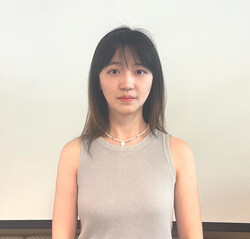
A collage shows 22 individual well-known PNe, artistically arranged in a spiral pattern by order of approximate physical size. Image credit: ESA/ Hubble and NASA, ESO, NOAO/AURA/NSF.
‘My interest in understanding the galaxy evolution encoded in the rich “fossil” of the Milky Way.’
Shuyu TAN, Research Assistant at HKU Laboratory for Space Research
Research Focus: The evolution of the milky way
Research Focus: The evolution of the milky way

Miss Shuyu TAN
Research Assistant at HKU Laboratory for Space Research
When stars reach the end of their lives, they exhaust their nuclear fuel and expel outer layers of gas and dust into space, forming planetary nebulae (PNe) with diverse shapes and properties. These PNe often align in a striking and seemingly coordinated manner, as if they are following a cosmic pattern, which remained a mystery to astrophysicists for a long time. However, a recent study led by Shuyu Tan at LSR uncovered insights into this enigma.
By analysing extensive data collected over the last decade, Shuyu’s team found that PNe with close binary stellar companions — pairs of stars orbiting closely, exhibit a pronounced alignment. This discovery suggests the influence of a persistent and strong magnetic field at the centre of our Galaxy in shaping these nebulae. Shuyu’s study paves the way for further exploration of this phenomenon, enhancing our understanding of the origin and evolution of the Galactic magnetic field and its role in star formation.
A Journey of Chasing Cosmos
Shuyu was intrigued by the interconnections of seemingly unrelated phenomena from an early age. ‘Even the use of standard candles piqued my interest as they demonstrated a way of thinking that navigated the known amidst the vast sea of the unknown.’
Shuyu’s decision to major in physics was driven by her ambition to understand the universe. During her second year of undergraduate studies at Imperial College UK, her research project using Gaia data released two uncovered snail-shell structures in the phase space of stars, hinting at a disturbance from the Sagittarius dwarf galaxy 500 million years age. ‘Since then, my interest in understanding the galaxy’s evolution, as encoded in the rich “fossil” of the Milky Way, including resolvable stars and the interstellar medium, has been ignited.’
She took pleasure in utilising statistical and computational tools for astrophysical research during her MPhil studies at HKU Physics, refining her skills in extracting information from publications, comprehending prior studies, and interpreting observational data. This marked her initial venture into observational astronomy, where she discovered the potency of data science and top-tier observations, attracting her to theoretical approaches and astrostatistics.
Currently serving as a Research Assistant at LSR under the supervision of the Director Professor Quentin PARKER, she recently collaborated with him to solve a 20-year-old astrophysical puzzle regarding low sulfur levels in PNe. By leveraging the state-of-the-art European Southern Observatory 8m Very Large Telescope in Chile, they traced the anomaly to poor data quality, disproving previous claims of underestimated ionisation stages or weak fluxes. Their findings offer vital insights into PNe composition, emphasising the significance of meticulous analysis in astrophysics.
In her current role, Shuyu describes her work as a blend of monotony and excitement. She elaborates, ‘While the tasks can sometimes feel repetitive, I find the challenge of adapting and applying innovative data analysis methods from various sources intellectually stimulating. This constant quest for improvement and innovation keeps me engaged.’
As Shuyu continues to delve deeper into the enchanting realm of astrophysics, she dreams of unravelling the universe’s hidden mysteries, igniting a passionate pursuit to soar beyond the stars, both for herself and the cosmic dreamers of tomorrow.
'Disappearing' Sulphur in Planetary NebulaeMysterious aligment of ghost starsLearn more about Shuyu's research
Supervisor: Professor Quentin PARKER, Professor and Director of the HKU Laboratory for Space Research |
| < Previous | Next > |


